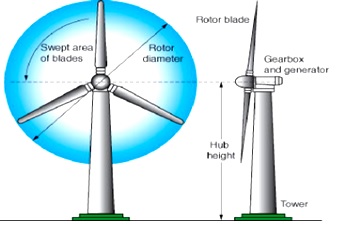Scenario of Offshore Wind Power Generation in India

DOI:
https://doi.org/10.54060/jmce.v3i1.28Keywords:
Wind power, offshore wind farms, Present scenario of wind industryAbstract
An exponential increase has been seen in the human population in the last few years. To meet the electricity requirement production has to be increased. The dependence on fos-sil fuels for generation has to be minimized. The practices of fossil fuel have contributed to the environmental degradation and its resources depleted continuously, that’s why the whole world is switching to an alternate or renewable energy options. The electricity sector has to develop more generation capacity to maintain this development. According to 2012 data, only a small fraction (26GW) of India's total installed electricity capacity (210GW) produced from renewable sources. Hence Indian Government wants to shift to renewable forms of energy source share 40-42% of the total energy production i.e., 166GW. The share of wind energy is 60% of the total renewable energy basket, but the contribution from the offshore wind farms is lacking, as the wind energy generated in India is mostly through onshore wind farms. Promotion of offshore wind energy will farm will lead to reduction in dependency on fossil fuels, deplete in greenhouse emis-sion, increase in environmental conservation and increase employment in India. India is coping up with the industry. Offshore wind energy is an emergent renewable energy industry, and it will become as main source of the future energy for India. This paper deals with the present situation and drift of offshore wind industries in India.
Downloads
References
T. Dhingra & S. Mani, “Policies to accelerate the growth of offshore wind energy sector in India,” Renewable and Sustainable Energy Reviews, vol.24, pp.473-482, 2013.
V.Fuskele, P..Baredar, R.M. Sarviya, et al., “Wind Turbine Nacelle Cooling Systems: A review,” WIRE-Energy and Environment Journal (Wiley), vol.11, no.6, pp.1-13, 2022.
P. B. Dash, “Developing Offshore wind energy in India,” Assessed on pp.1-25, 2022. https://mnre.gov.in/img/documents/uploads/2e423892727a456e93a684f38d8622f7.
R. M. Murali, P. J. Vidya, P. Modi, et al., “Site selection for offshore wind farms along the Indian coast,” Indian Journal of Geo-Marine Sciences, vol.43, no.7, pp.1401-1406, 2014.
R. Kumar, T. Stallard and P. K. Stansby, “Large‐scale offshore wind energy installation in northwest India: Assessment of wind resource using Weather Research and Forecasting and levelized cost of energy,” Wind Energy, vol.24, no.2, pp.174-192, 2021.
S. H. Jain, “Overview of renewable power generation, CEA,” Archived from the original on Re-trieved January 2023.https://cea.nic.in/renewable-project-monitoring/?lang=en
Offshore wind| Ministry of New and Renewable Energy, Government of India" Retrieved January 2023. https://mnre.gov.in/wind/offshore-wind/
T. Lu, P. Sherman, S. Chen, et al., “India’s potential for integrating solar and on-and offshore wind power into its energy sys-tem,” Nature communications, vol.11, no.1, pp.1-10, 2020.
N. Garlapati, V. Savasani, N. K. Naidu, et al., “Application of reanalysis data to estimate offshore wind potential in EEZ of India based on marine ecosystem considerations,” Energy, vol.118, pp.622-631, 2017.
C. R. Kumar, V. Kumar, M. Mazid, et al., “Offshore wind energy status, challenges, opportunities, environmental impacts, occu-pational health, and safety management in India,” Energy & Environment, vol.32, no.4, pp.565-603, 2021.
K. Boopathi, K. Balraman, J. Bastin, et al, “Assessment of wind power potential in the coastal region of Tamil Nadu India,” Ocean Engineering, vol.219, 2021.
R. Krishnamoorthy, K. Raju, L. M. Popa, et al., “An Assessment of Onshore and Offshore Wind Energy Potential in India Using Moth Flame Optimization,” Energies, vol.13, no.12, pp.1-41, 2021.
Gadad, S, Sanjeev and P. C. Deka, “Offshore wind power resource assessment using Oceansat-2 scatterometer data at a re-gional scale,” Applied Energy, vol.176, pp.57-170, 2016.
N. Garlapati, N. Naidu, V. Savsani, et al., “Feasibility study for offshore wind power development in India based on bathymetry and reanalysis data,” Energy Sources, Part A: Recovery, Utilization, and Environmental Effects, vol.39, no.5, pp.497-504, 2017.
S. V. V. A. Kumar, J. Prajapati, and R. Kumar, “Evaluation of offshore wind energy resources for power generation based on scatter meter and SAR data along the Indian coast,” Remote Sensing of the Oceans and Inland Waters: Techniques, Applica-tions, and Challenges SPIE Asia Pacific, vol. 9878, 2016.
J. I. Lewis, “Building a national wind turbine industry: experiences from China India and South Korea,” International Journal of Technology and Globalisation, vol.5, no.3-4, pp.281-305, 2011.
S. B. Kore, A. Lole, S. S. Shinde, et al., “Feasibility of offshore wind farm in India,” Int. Res. J. Eng. Technol, vol.3, no.11, pp.2395-3225, 2016.
Bilgili, Mehmet, A. Yasar, et al., “Offshore wind power development in Europe and its comparison with onshore counter-part,” Renewable and Sustainable Energy Reviews, vol.15, no.2, pp.905-915, 2011.
S. Sharma and S. Sinha, “Indian wind energy & its development-policies-barriers: An overview,” Environmental and Sustainabil-ity Indicators, vol.1, 2019.
T. Smit, M. Junginger and R. Smits, “Technological learning in offshore wind energy: Different roles of the government,” Energy policy, vol.35, no.12, pp.6431-6444, 2007.
S. Jay, “Planners to the rescue: Spatial planning facilitating the development of offshore wind energy,” Marine pollution bulle-tin, vol.60, no.4, pp.493-499, 2010.
R. W. Furness, H. M. Wade, E. A. Madson, et al., “Assessing vulnerability of marine bird populations to offshore wind farms,” Journal of environmental management, vol.119, pp.56-66, 2013.
N. Garlapati, S. S. Kachhwaha, V. Savsani, “Estimation of technical and economic potential of offshore wind along the coast of India,” Energy, vol.138, no.1, pp.79-91, 2017.
C. Makridis, “Offshore wind power resource availability and prospects: A global approach,” Environmental science & policy, vol 33, pp.28-40, 2013.
C. Mattar and D. Borvaran, “Offshore wind power simulation by using WRF in the central coast of Chile,” Elsevier, vol.94, pp.22-31, 2016.
D. Toke, “The UK offshore wind power programmed: A sea-change in UK energy policy,” Energy Policy, vol.39, no.2, pp.526-534, 2011.
E. A. Madson, “Renewable energy developments in an uncertain world: the case of offshore wind and birds in the UK,” Marine Policy vol.51, pp.169-172, 2015.
J. Bosch, J. Staffell and A. D. Hawkes, “Temporally explicit and spatially resolved global offshore wind energy poten-tials,” Energy, vol.163, no.15, pp.766-781, 2016.
C. Makridis, “Offshore wind power resource availability and prospects: A global approach,” Environmental science & policy, vol.33, pp.28-40, 2018.
F. Pimenta, K. Willett and R. Garvine, “Combining meteorological stations and satellite data to evaluate the offshore wind pow-er resource of Southeastern Brazil,” Renewable Energy, vol.33, no.11, pp.2375-2387, 2018.

Downloads
Published
How to Cite
CITATION COUNT
Issue
Section
License
Copyright (c) 2023 Anubhav Singh, Dharmraj Meena, Shanti Lal Meena, Shiv Lal

This work is licensed under a Creative Commons Attribution 4.0 International License.
























